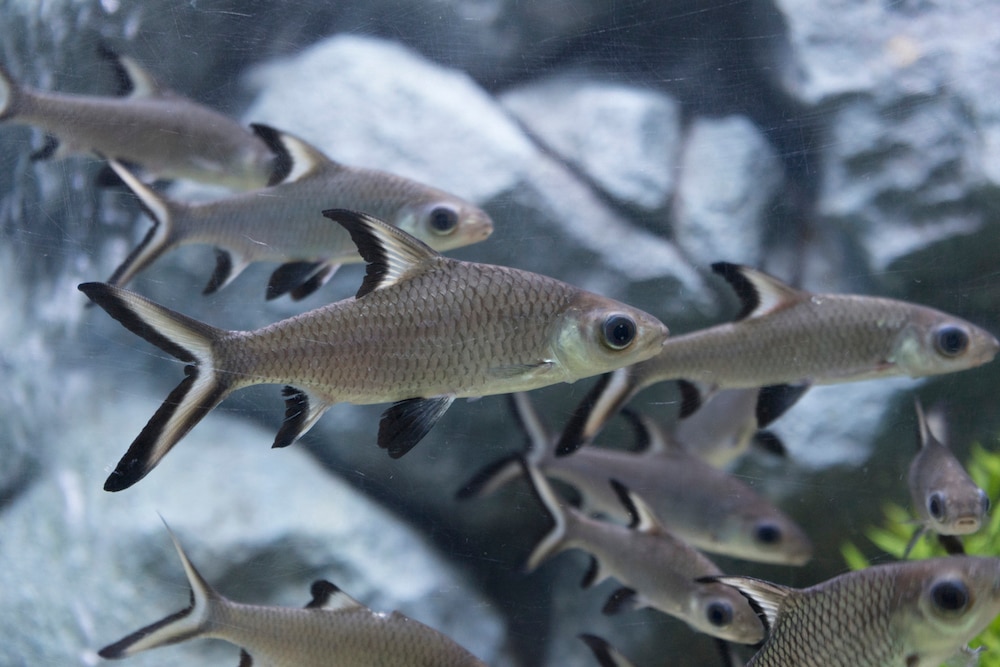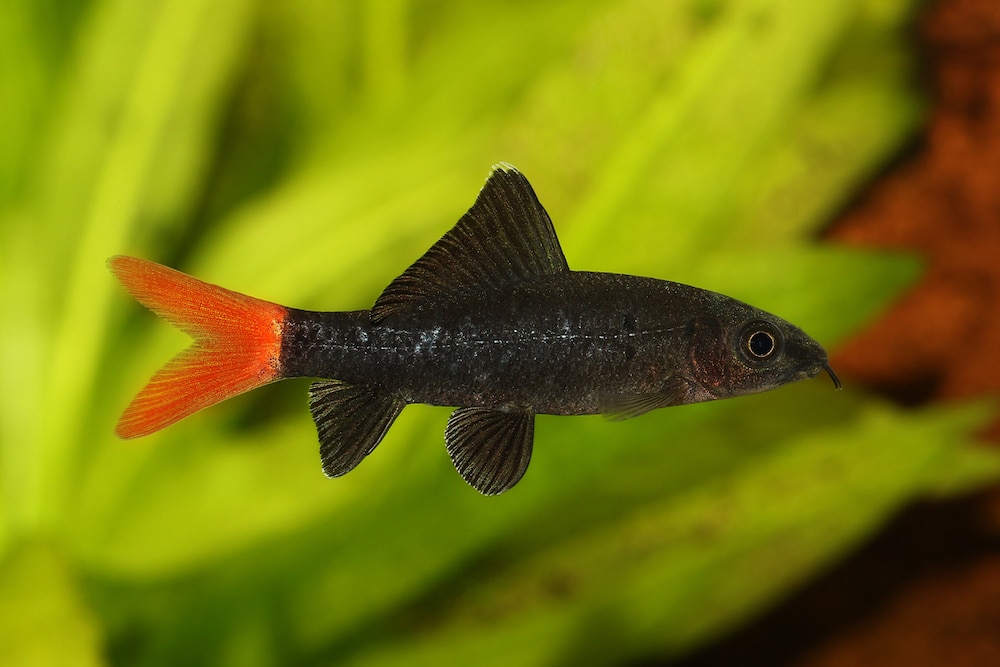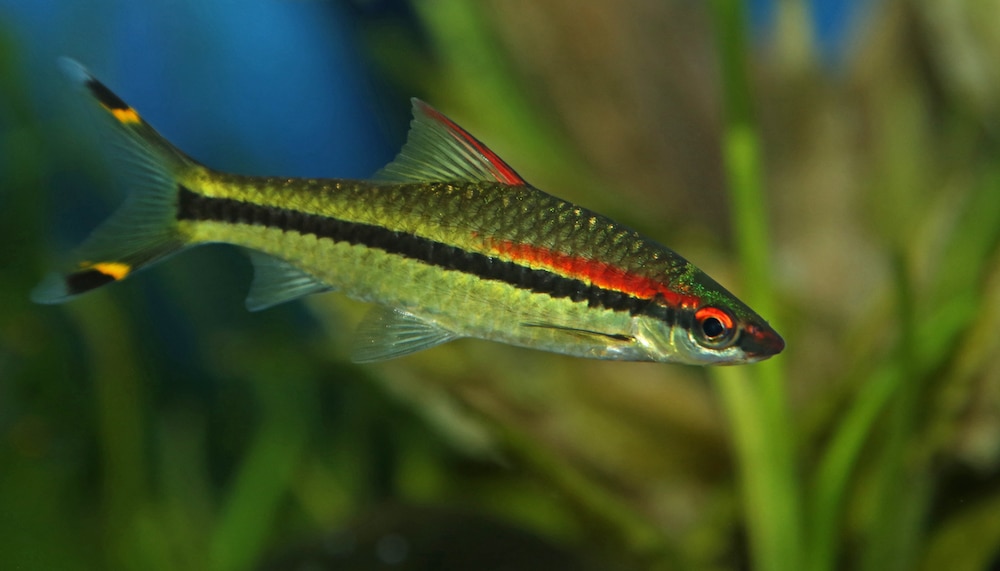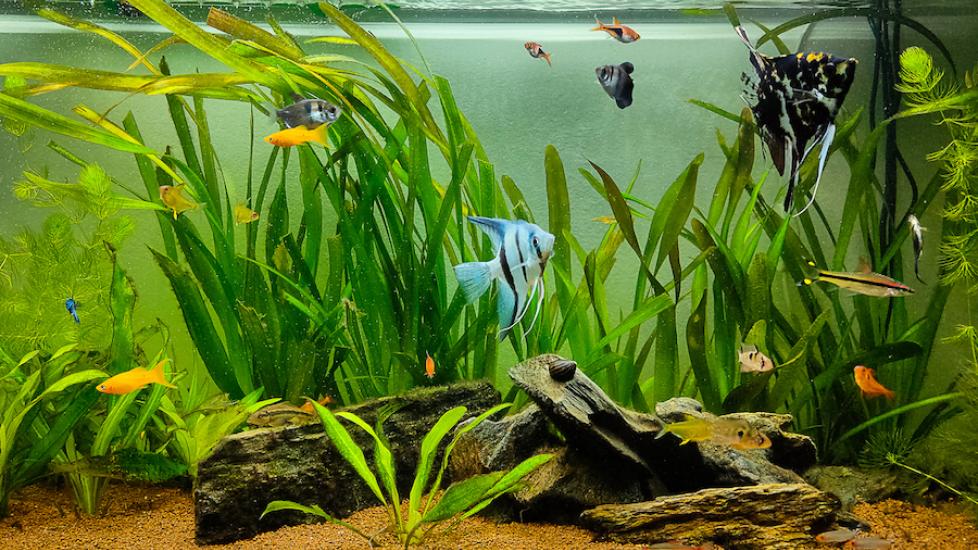Top 9 Freshwater Sharks for Aquariums
There are many shark species available in the aquarium hobby. However, freshwater sharks are not true sharks, but rather named for their shark-like appearance. Freshwater sharks tend to be sleek and streamlined, requiring lots of room for swimming, and can come in a variety of colors and temperaments. Learn more about all the common freshwater shark species to pick one for your aquarium.
What Freshwater Sharks Can You Keep in an Aquarium?
Bala Shark

The Bala shark is very “shark-like” in its appearance with a silvery body and black tipped fins. A member of the Cyprinid family, the Bala Shark is a peaceful, community omnivore that does well in many aquarium setups. They require at least 125 gallons per fish since they can grow up to 13 inches long and often come in a school (pack of sharks)—so a very large tank is required.
Rainbow Shark

The Rainbow shark is a member of the Cyprinid family and has a dark black body with bright red fins—very similar to the Bala shark but tends to be a more aggressive and only grows up to 6–7 inches long.
Given their nature and despite their small size, they require more territory at approximately 50–75 gallons per fish. There is also an albino variety of this species that has a pale body, red, non-pigmented eyes, yet still has the red fins.
Red Tail Shark

The Red Tail shark is closely related to the Rainbow shark. They are similar in coloration, with the Red Tail having a red tail fin wand their other fins being black. Although they are of the same genus, the Red Tail shark has been categorized as more aggressive than the Rainbow shark. The Red Tail shark can reach about 6–7 inches long and will require 50–75 gallons of water per fish.
Violet Blushing Shark
The Violet Blushing shark has a very light body color with an almost translucent gill cover where you can actually see the gills through their head. These sharks can grow up to 12 inches long and do well in a school but will require up to 125 gallons of water initially.. They do OK in freshwater community tanks, provided there are no smaller fish that would be considered prey.
Black Shark
The Black shark is one of the largest freshwater shark species, topping out at 2 to 3 feet long! They can be very aggressive fish and require at least 200 gallons of water per fish. Their entire body is black and have typical carp-like bodies with a torpedo shape, barbels/whiskers, and large scales. Unlike other large fishes, such as goldfish and koi, they have a very narrow temperature range and should not be kept in outdoor ponds.
Roseline Shark

Also commonly known as a Denison barb, the Roseline shark is characterized by a silver body with a black stripe along the length, and black-tipped fins with a red stripe along the eye and front half of the body.
They tend to grow up to 4–5 inches long and need to be kept in a small school of at least 5–6 sharks. Roseline sharks are considered an endangered species but are available as captive-bred individuals in the aquarium hobby.
Harlequin Shark
With their camouflage body appearance, the Harlequin shark likes planted tanks with lots of places to hide. The Harlequin shark is shy and prefers to live as an individual, not in a school. They can grow up to 6 inches long and require considerable space given their solitary nature of up to 50 gallons per fish.
Chinese High-Fin Banded Shark

The Chinese High-Fin Banded shark, also known as the Chinese Suckerfish, is common in both the indoor tank and outdoor pond fishkeeping hobby. This fish has dark and pale bands on their sides when they are younger, which can become darker as they grow older. The Chinese High-Fin Banded shark can grow up to 24 inches long and is a benthic fish, meaning they prefer to stay on the bottom of the tank or pond, propped up on their fins.
Silver Apollo Shark
The Silver Apollo shark is a freshwater shark with a silvery-gold body and a faint black/brown stripe along their body with silvery fins. These fish are known to be fast-moving and like being kept in a small school of at least 5–6 individual fish. They can grow up to ten inches, so a group will require at least 125 gallons of water. These sharks tend to get along well with other medium-sized community fish species.
What Is the Best Freshwater Aquarium Shark?
The best freshwater shark for first time freshwater shark enthusiasts is the Roseline shark. These fish are readily available, easy to keep, and can be kept in a smaller aquarium. They are not overly aggressive and bring a bright splash of color with lots of dynamic movement.
What Is the Smallest Freshwater Shark for an Aquarium?
The Roseline shark, or Denison barb, is the smallest freshwater fish species, topping out at only 4–5 inches.
Which Shark Is Easiest to Care For?
The easiest freshwater shark species to care for is the Roseline shark. These smaller, community-minded freshwater sharks are bred in captivity, making them easy to obtain and keep in an aquarium on a varied tropical diet.
Which Sharks Are Least Aggressive?
The least aggressive freshwater shark species is the Chinese High-Fin Banded shark. These bottom-dwelling sharks are peaceful and easygoing but will require a lot of room since they can grow very large.
Freshwater Shark Care Tips
Cleaning Recommendations
When it comes to freshwater sharks, they are not as fussy about having pristine water chemistry as saltwater sharks. However, you will still need to carefully consider what water quality parameters each species prefers, since they are not all the same. For any new fish species, always do your research to ensure your new fish will fit the temperament, water quality requirements, environment, and available diets that you currently have.
Size of Your School
The number of sharks in a school will vary by species. Many of the above species like to be in groups, but can grow to a large size, so you will need to plan accordingly to increase the size of their aquarium. Other species, such as the Harlequin shark, do better as solitary individuals.
Best Food for Aquarium Sharks
Since they are not true sharks, freshwater aquarium sharks typically do well on a varied omnivore community diet. This should include a well-balanced pelleted diet mixed in with fresh vegetables and meaty treats.
How to Feed Freshwater Sharks
Keep in mind with mixed species tanks that some fish may be more aggressive than others or enjoy different diets. The best approach is to use a broadcast feeding: spreading the food out through the surface and adding it directly to any filter outflows in order to administer it to fish at the bottom of your tank. Watch your fish carefully during feeding time to ensure that everyone gets enough food and no one is left out.
Featured Image: iStock.com/Juan Carlos Juarez Jaramillo
